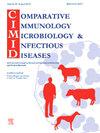伊朗西部家畜硬蜱标本巴尔通体属的系统发育分析
IF 2
3区 农林科学
Q4 IMMUNOLOGY
Comparative Immunology Microbiology and Infectious Diseases
Pub Date : 2025-07-02
DOI:10.1016/j.cimid.2025.102369
引用次数: 0
摘要
巴尔通体作为感染各种家养和野生哺乳动物的新媒介传播病原体,由于其作为人畜共患病原体的作用,对公共卫生构成重大威胁。本研究的目的是确定巴尔通体属和种的流行情况,并对这些生物在伊朗西部5个省(Hamedan、Kermanshah、Lorestan、Ilam和Kurdistan)的蜱中进行系统发育分析。蜱虫也从狗、绵羊和山羊身上收集到。总共收集了978只蜱虫,随后分成10个池。采用特异性引物进行聚合酶链反应(PCR)检测巴尔通体的存在。此外,基于rpoB、gltA、ftsZ、groEL和ribC基因进行序列分析,确定巴尔通体的存在。并用MEGA 11软件进行系统发育分析。基于gltA基因的巴尔通体在98份样本中总体流行率为5(5.01 %)(95% % CI: 2.20 % ~ 11.39 %)。值得注意的是,只有在伊拉姆省和哈马丹省出现了消极的结果。通过gltA、groEL、ftsZ、rpoB和ribC基因的系统发育分析,证实了金塔巴尔通体、克拉氏巴尔通体和巴尔通体属的存在,相似度为96.96 %-100 %。根据这些发现,可以推测巴尔通体属和种,特别是B. quintana和B. clarridageiae存在于伊朗西部的蜱虫中。本文章由计算机程序翻译,如有差异,请以英文原文为准。
Phylogeny analysis of Bartonella genus in hard tick samples associated to domestic animals in west of Iran
Bartonella, as emerging vector-borne pathogens infecting various domestic and wild mammals, pose a significant threat to public health due to their role as zoonotic agents. The objective of this study was to ascertain the prevalence of the genus and species of Bartonella and to conduct a phylogenetic analysis of these organisms in ticks from five western provinces Hamedan, Kermanshah, Lorestan, Ilam, and Kurdistan, in Iran. Ticks were also collected from dogs, sheep, and goats. A total of 978 ticks were collected and subsequently divided into pools of 10. Polymerase chain reaction (PCR) assays were performed using specific primers to screen for the presence of Bartonella species. Additionally, sequence analysis was conducted based on the rpoB, gltA, ftsZ, groEL, and ribC genes to identify the presence of Bartonella. Phylogentic analysis was also performed using MEGA 11 software. The overall prevalence of the genus and species of Bartonella based on the gltA gene in 98 pooled samples in the study areas was 5 (5.01 %) (with a 95 % CI: 2.20 %-11.39 %). It is noteworthy that negative results were observed only in Ilam and Hamadan provinces. The presence of Bartonella quintana, Bartonella clarridageiae and Bartonella spp. was confirmed by phylogenetic analysis of the gltA, groEL, ftsZ, rpoB, and ribC genes, with a similarity of 96.96 %-100 %. In light of these findings, it can be posited that the genus and species of Bartonella, particularly B. quintana and B. clarridageiae are present in the ticks of western Iran.
求助全文
通过发布文献求助,成功后即可免费获取论文全文。
去求助
来源期刊
CiteScore
4.60
自引率
0.00%
发文量
102
审稿时长
40 days
期刊介绍:
Comparative Immunology, Microbiology & Infectious Diseases aims to respond to the concept of "One Medicine" and to provide a venue for scientific exchange. Based on the concept of "Comparative Medicine" interdisciplinary cooperation between specialists in human and animal medicine is of mutual interest and benefit. Therefore, there is need to combine the respective interest of physicians, veterinarians and other health professionals for comparative studies relevant to either human or animal medicine .
The journal is open to subjects of common interest related to the immunology, immunopathology, microbiology, parasitology and epidemiology of human and animal infectious diseases, especially zoonotic infections, and animal models of human infectious diseases. The role of environmental factors in disease emergence is emphasized. CIMID is mainly focusing on applied veterinary and human medicine rather than on fundamental experimental research.

 求助内容:
求助内容: 应助结果提醒方式:
应助结果提醒方式:


